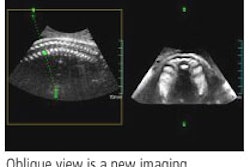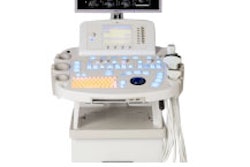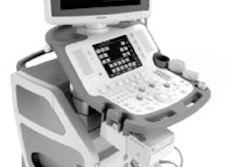Ultrasound is as indispensable in the intensive care unit (ICU) as the bedside nurse, according to a critical care specialist. In several presentations at the 2006 Society of Critical Care Medicine (SCCM) meeting in San Francisco, ICU doctors offered examples of how they make the most of sonography in their field.
In an introductory talk, Dr. Kathryn Tchorz reviewed some ultrasound basics. Tchorz is an assistant professor of surgery in the division of burn, trauma, and critical care at the University of Texas Southwestern Medical Center-Parkland Memorial Hospital in Dallas.
In the intensive care setting, low-frequency ultrasound is generally preferred for imaging deep structures such as the heart, thorax, and abdomen. High frequency is better for superficial structures that are close to skin such as breast imaging, checking for deep venous thrombosis (DVT), or evaluating testicular flow, Tchorz explained.
"As we increase the frequency, we shorten the wavelength and this increases the imaging resolution. Depending on the clinical need, we select the transducer which is appropriate," she said. A convex transducer is better for looking at the abdominal cavity and the thorax. A linear transducer is best for superficial structures.
Ultrasound artifacts can be very useful in the ICU as well. "Imaging artifacts are very important because sometimes they can help us with the clinical diagnosis. They are considered errors in ultrasound imaging, but they can help us with the diagnosis of certain pathologic entities," Tchorz said.
For instance, posterior acoustic shadowing can identify hyperechoic gallstones. On the other hand, posterior acoustic enhancement can spot fluid-filled structures, such as a full bladder, she explained. Finally, reverberation artifacts, or comet tails, can be used to judge for the presence or absence of pneumothorax.
US for chest
Dr. Paul Marik said that he always takes his portable ultrasound scanner with him when he makes his rounds at Thomas Jefferson University Hospital in Philadelphia. But he hopes his colleagues don't take it as a sign that he is trying to horn in on their territory.
"I think it's important for our cardiologists and radiologists to know that we aren't competing with them," Marik said during his SCCM talk. "Handheld ultrasound at the bedside doesn't replace echocardiography or (traditional) ultrasound. It's used as an extension of physical examination.... I find it as indispensable as a bedside nurse."
Marik, who is from the division of pulmonary and critical care medicine, urged SCCM attendees to consider portable ultrasound as a regular part of their ICU armamentarium. "Once you've rounded with (handheld ultrasound), one feels half naked without using one," he said.
Marik said that there are two main uses for bedside ultrasound: to diagnose pleural effusions and for guiding thoracentesis.
For pleural effusions, ultrasound is invaluable for measure the distance between the surface and the pleura, and the pleura and the lung, Marik said. Based solely on sonographic findings, he has been able to treat pleural effusions almost immediately with thrombolytics, he said. In addition, ultrasound scanning can be beneficial for guiding drainage of pleural effusions, especially small ones.
Marik also strongly recommended ultrasound guidance for thoracentesis as it allows the clinician to visualize the chest in all three dimensions.
"In this day and age, it is medical malpractice to do a thoracentesis in the ICU without handheld ultrasound," Marik said. "Recently, we had a cardiothoracic fellow who (accidentally) put a (drainage catheter) into the liver and the patient demised. (Thoracentesis) with handheld ultrasound is so easy and efficient. We've not had a single complication using our technique."
Marik suggested to SCCM attendees that they reference the work of Dr. Daniel Lichtenstein for more details on sonographic signs in the chest, although he cautioned that Lichtenstein's naming system for these signs can get very complex (Critical Care Medicine, June 2005, Vol. 33:6, pp.1231-1238; Chest, November 1995, Vol. 108:5, pp. 1345-1348).
Echo for volume status
Is transesophageal echocardiography (TEE) the best way to tell the cardiac volume status of an ICU patient? Yes, according to Dr. David Porembka, who is the director of perioperative echocardiography at the University of Cincinnati's College of Medicine.
"Ultrasound exam should be part of the standard of care in the ICU," Porembka said in his talk. "I cannot tell clinically what is the (cardiac) function of the patient ... unless I have some technology in real-time to show me. That's where echo has made a difference."
TEE offers information about the condition of the ICU patient's heart as well as any pre-existing heart conditions, such as hypertension and ischemic heart disease. In addition, ultrasound can reveal whether the current disease state is affecting the heart in terms of volume. The volume of the heart may well determine how successful any treatment will be, Porembka said.
"Pressure does not mean adequate flow. Flow does not necessarily mean adequate volume or pressure," he said. "You can get a lot of info from the echo and decide what is wrong with the left side and the right side in cardiac function."
As Porembka mentioned, TEE is useful for evaluating the left and ride sides of the heart in terms of preload, or all of the factors that contribute to passive ventricular wall stress (or tension) at the end of diastole, and afterload, which can be defined as all of the factors that contribute to total myocardial wall stress (or tension) during systolic ejection (Advances in Physiology Education, December 2001, Vol. 25:1-4, pp. 53-61).
"The left side is a volume-working conduit. The right side is a thin envelope that does not tolerate high, ventricular volume," Porembka said. "You have to intervene quickly and early with (ICU) patients and sometimes with echo, you can get the information you need."
Other situations in which TEE assessment has value include:
- Wall tension
- Peripheral vascular tension
- Cardiac tamponade
- Endocarditis
- Pulmonary embolism
The next phase in TEE will be the construction of pressure-volume loops, he said. The pressure-volume relationship is the most reliable index for assessing myocardial contractility in the intact circulation and is almost insensitive to changes in preload and afterload (Cardiovascular Ultrasound, September 8, 2005, Vol. 3:27).
US intervention
In the last presentation, Dr. Heidi Frankel reviewed what she called the "nuts and bolts" for portable ultrasound in the ICU. Frankel is also an associate professor of surgery at the University of Texas Southwestern Medical Center in Dallas.
Frankel reiterated that the main uses for ultrasound guidance are in central line placement and thoracentesis. The most basic ultrasound units are best reserved for central line placement, she said.
"(This) basic unit ... has a small screen and it comes with the higher-frequency transducer, which allows you to see close structures very well. On the other hand, it doesn't allow you to penetrate those structures," she explained. "The advantage of this is that it's a really simple piece of equipment for ultrasound-guided insertions."
Frankel added that in some very thin patients or in children, it may be possible to use this basic sonographic unit to see deeper into the abdomen. In terms of the transducer itself, Frankel said that either can be used, although she recommended against a linear transducer for subclavian line insertions.
In most cases imaging can be done beforehand using the x-marks-the-spot technique, she said, especially in the case of thoracentesis of large effusions. However, Frankel stressed that the ICU physician should be doing his or her own marking, rather than having the radiologist do it first.
For central venous insertion, Frankel said she opts for real-time sonography. She also mentioned that many central line kits are now equipped with an echogenic tip that allows the user to see the needle going all the way through. Real-time imaging is also an excellent tool for trainees to hone their line insertion techniques, she said.
For inexperience users, she recommended that the transducer be held in the nondominant hand. The needle should be kept parallel to the axis of the transducer, which orients it perpendicular to the ultrasound beam. Also, Frankel stressed the importance of keeping the target at the center of the screen. New users have a tendency to make very large loops when learning to work with ultrasound, which are not necessary; very small hand movements will produce more accurate results.
Once ultrasound-guidance experience is gained, it can be used in many creative ways, Frankel concluded. These include the placement of tubes and drains, such as suprapubic catheters. Also, ultrasound guidance can be used to identify and drain hematomas and abscesses, as well as guidance for bedside inferior vena cava filter placement.
By Shalmali Pal
AuntMinnie.com staff writer
February 2, 2006
Related Reading
US guidance keeps central catheter placement on target, January 11, 2006
Chest x-ray after thoracentesis adds little new information, December 26, 2005
CT venography offers DVT alternative to ultrasound in ICU, August 19, 2005
Copyright © 2006 AuntMinnie.com



















